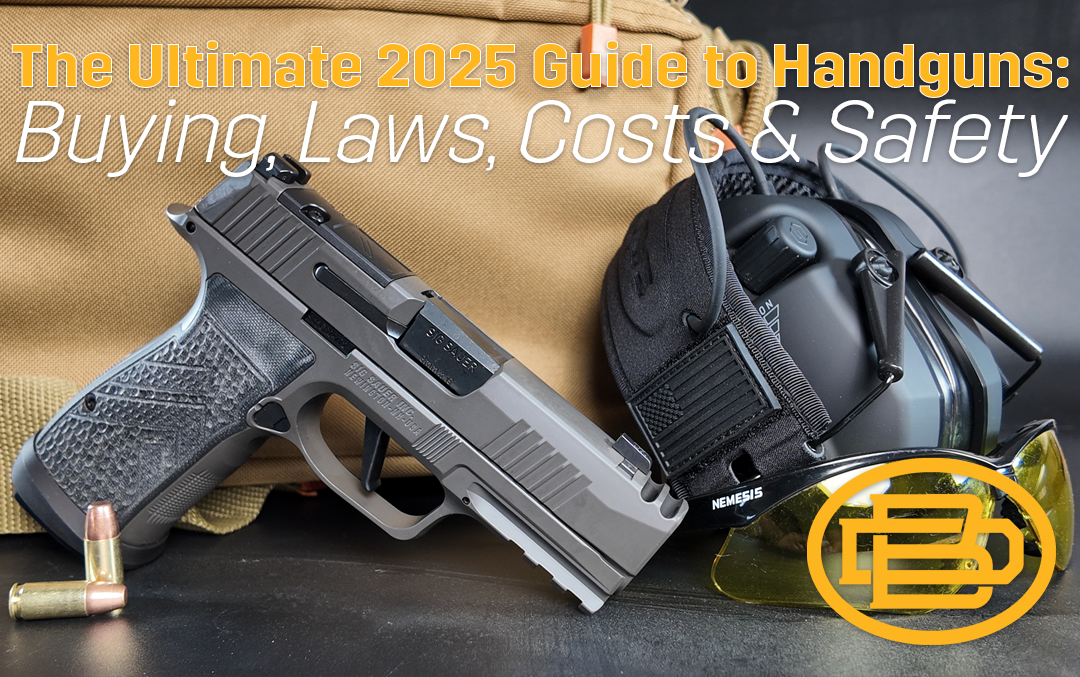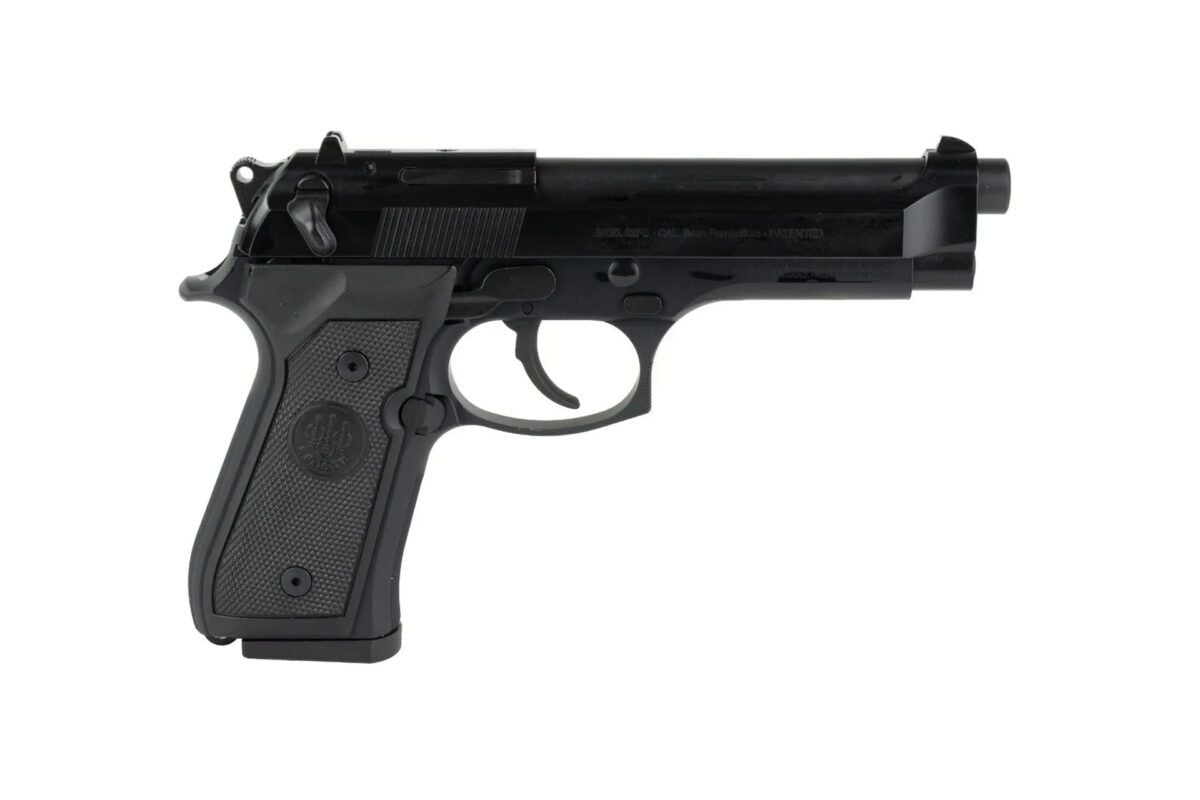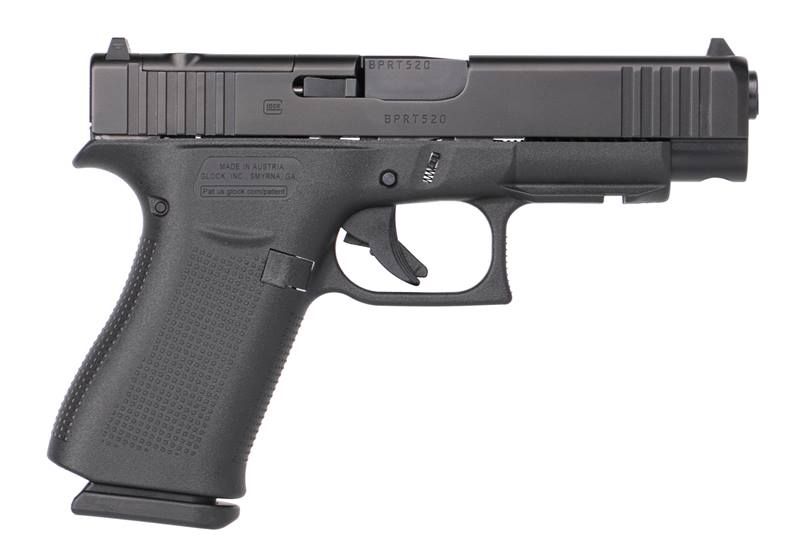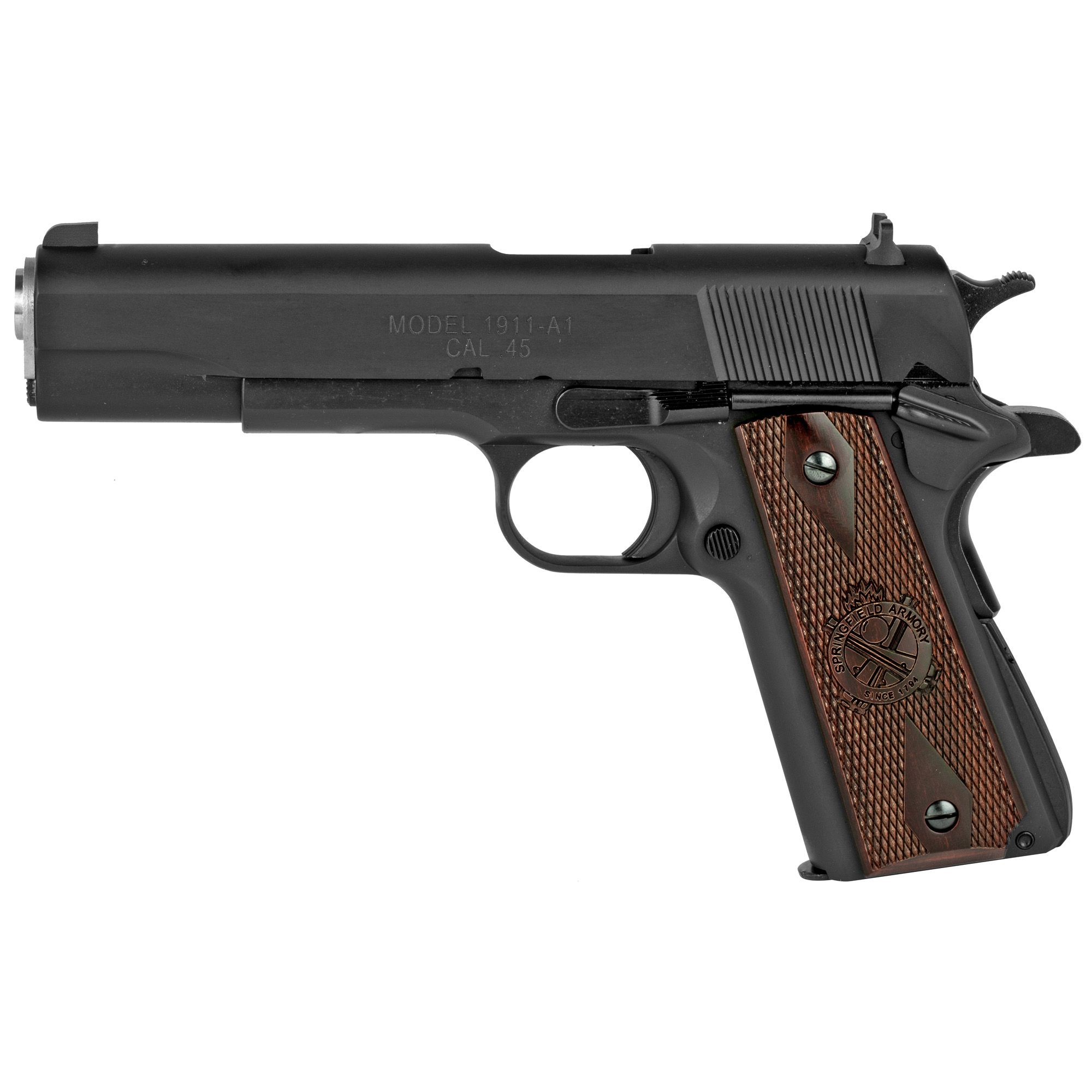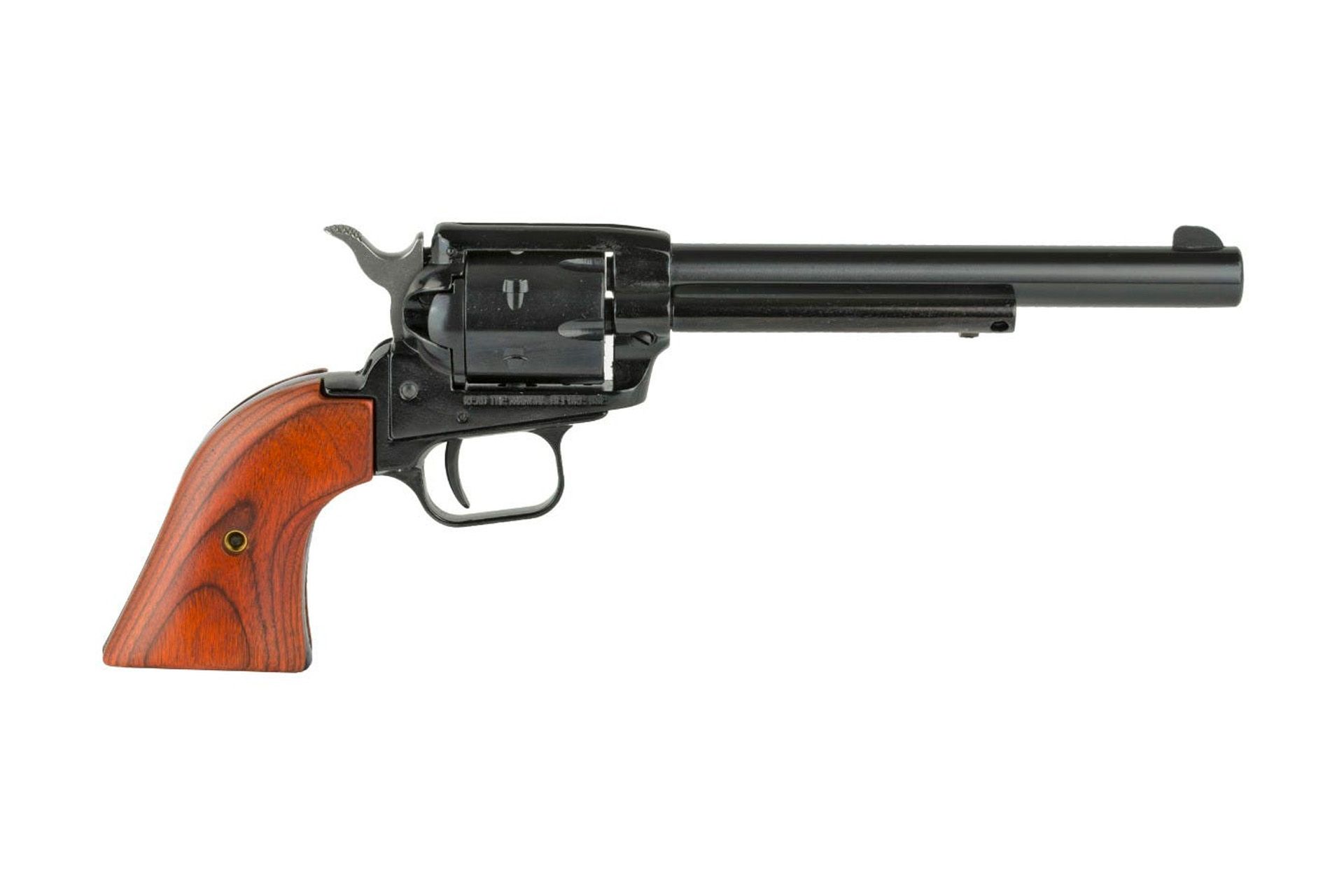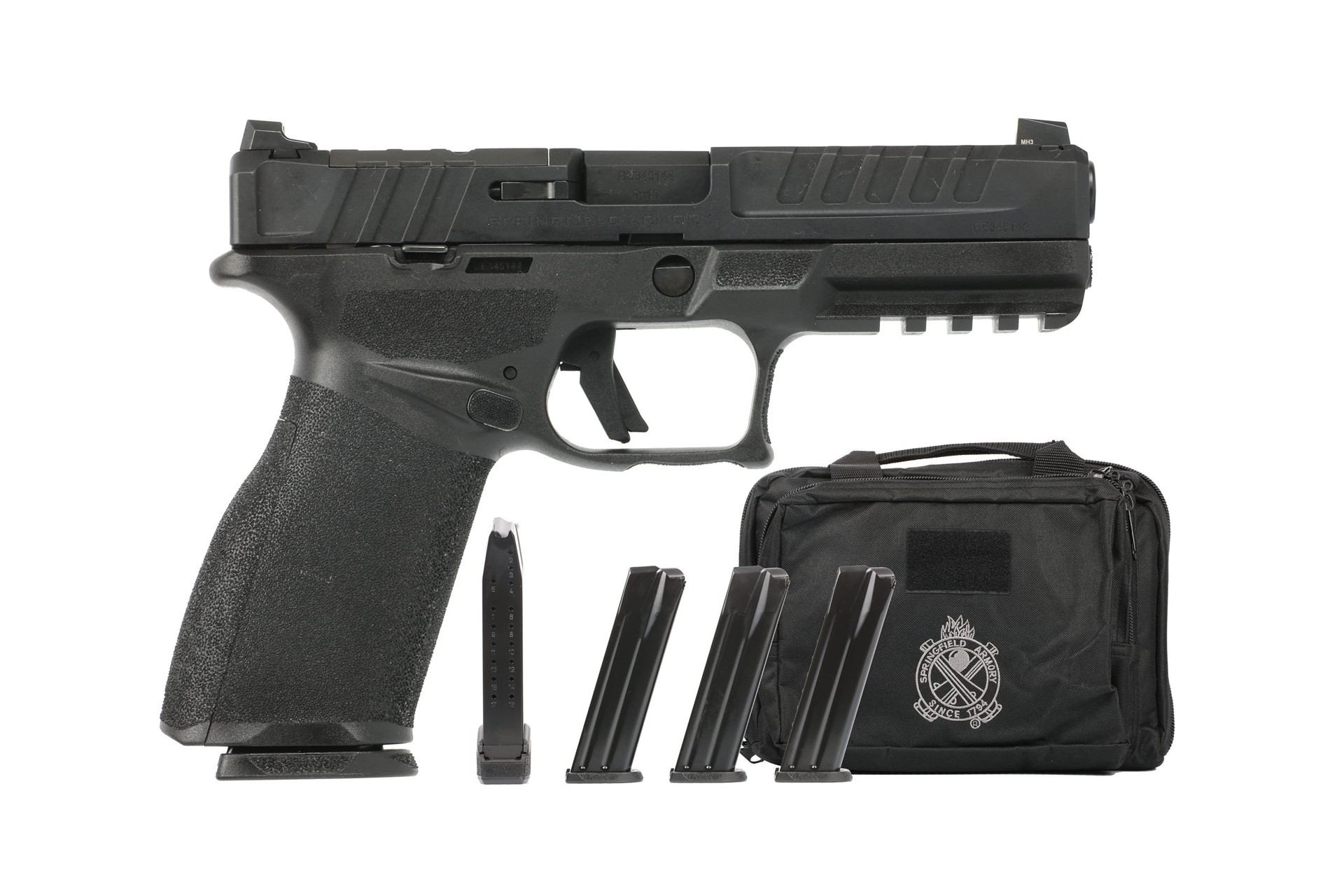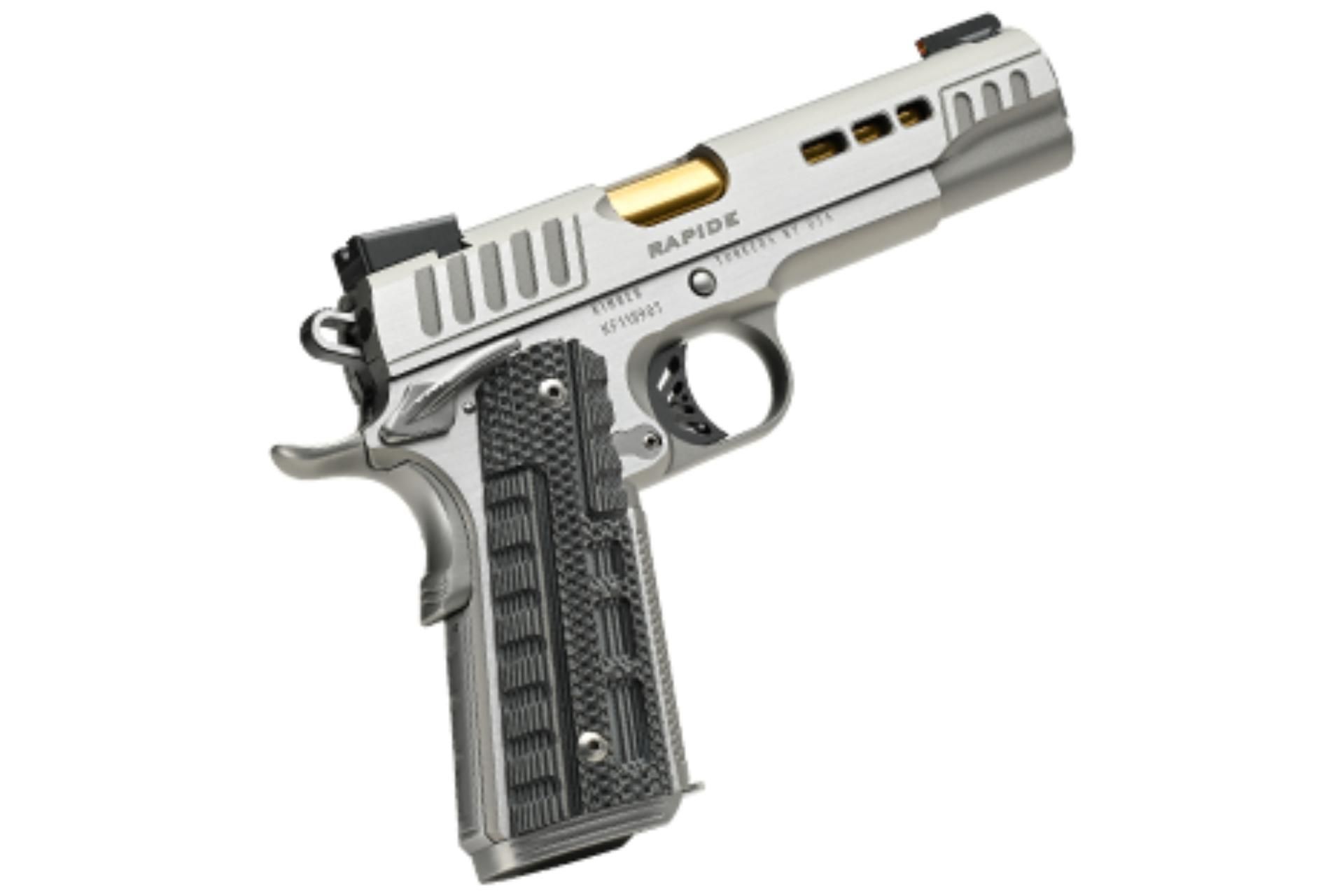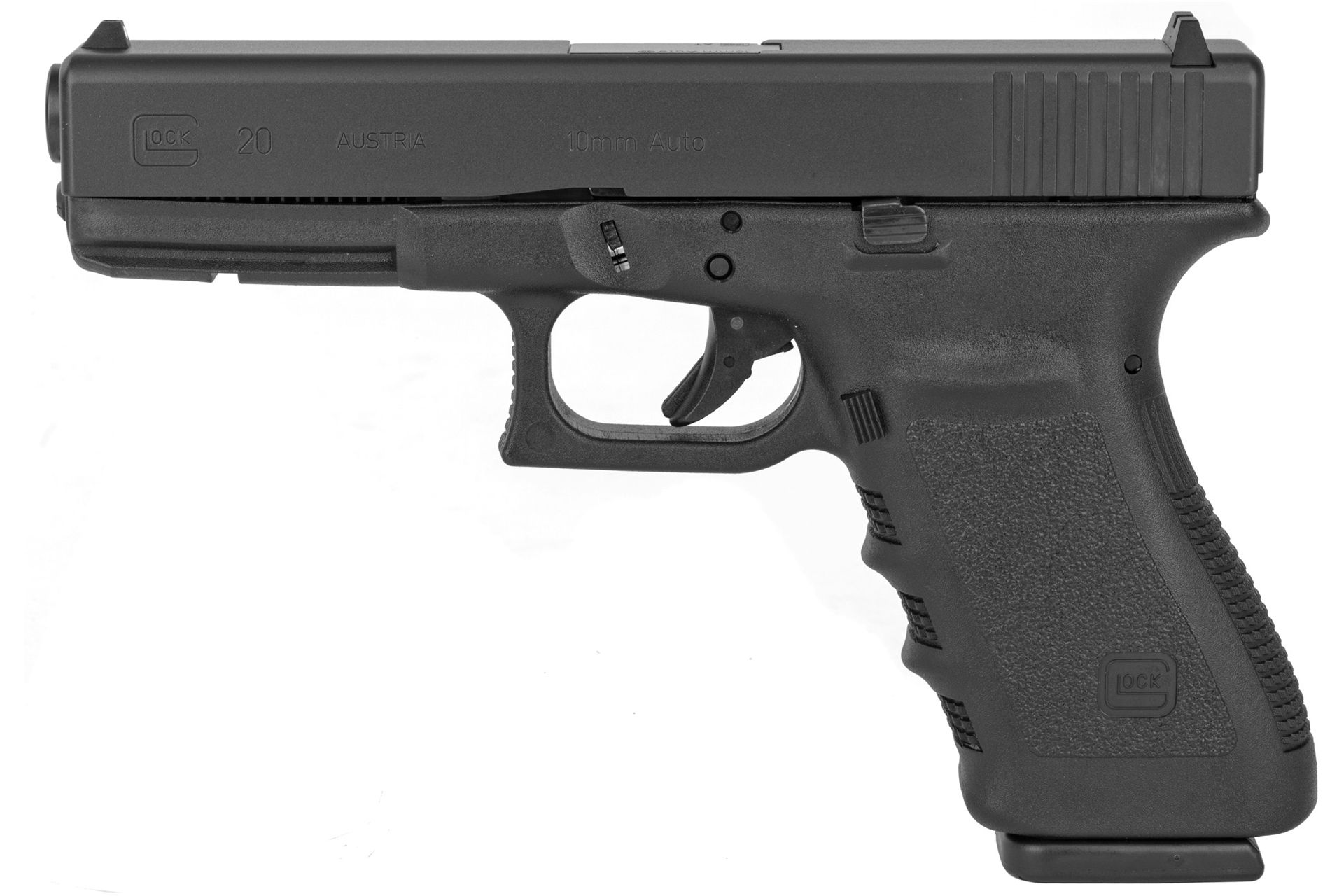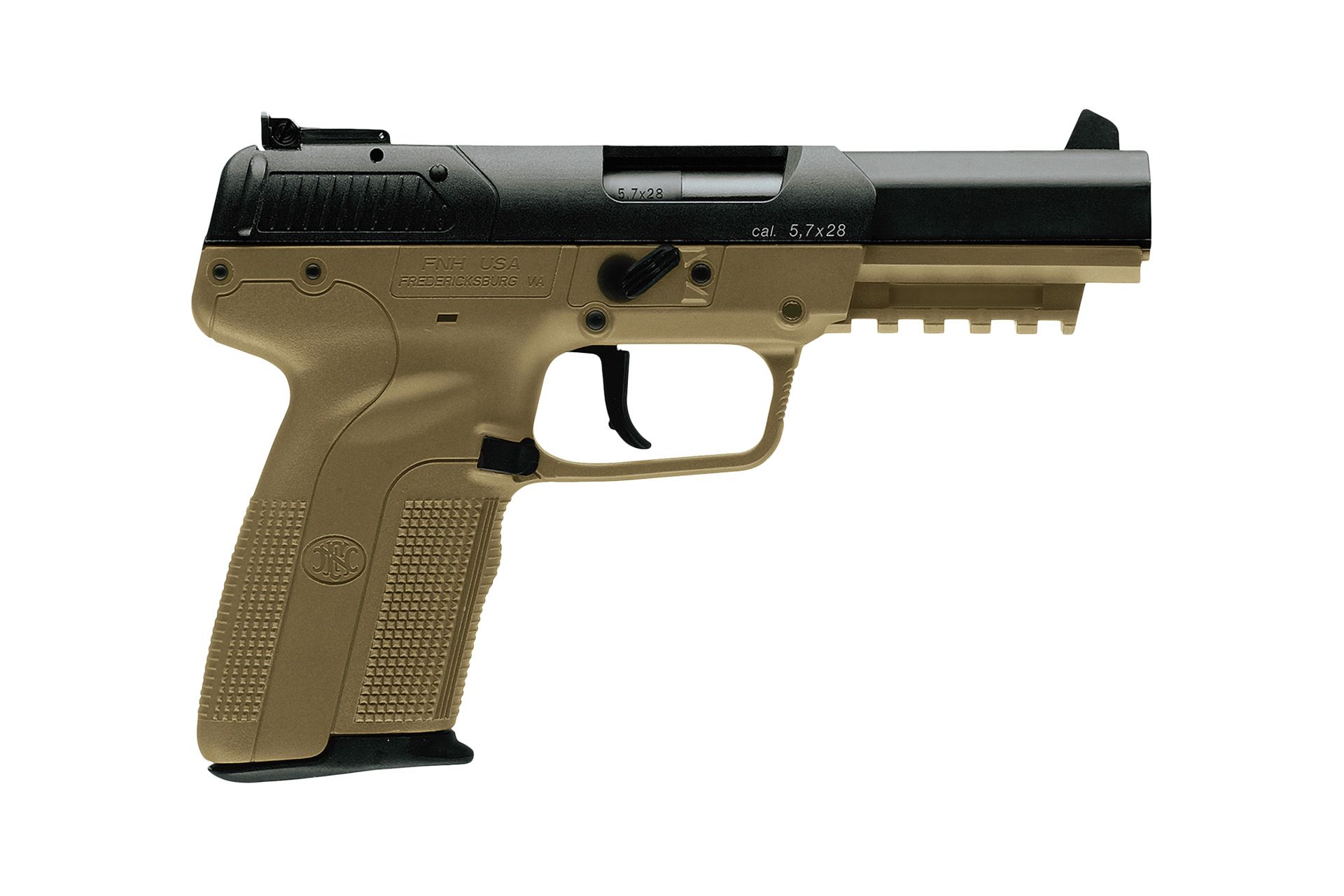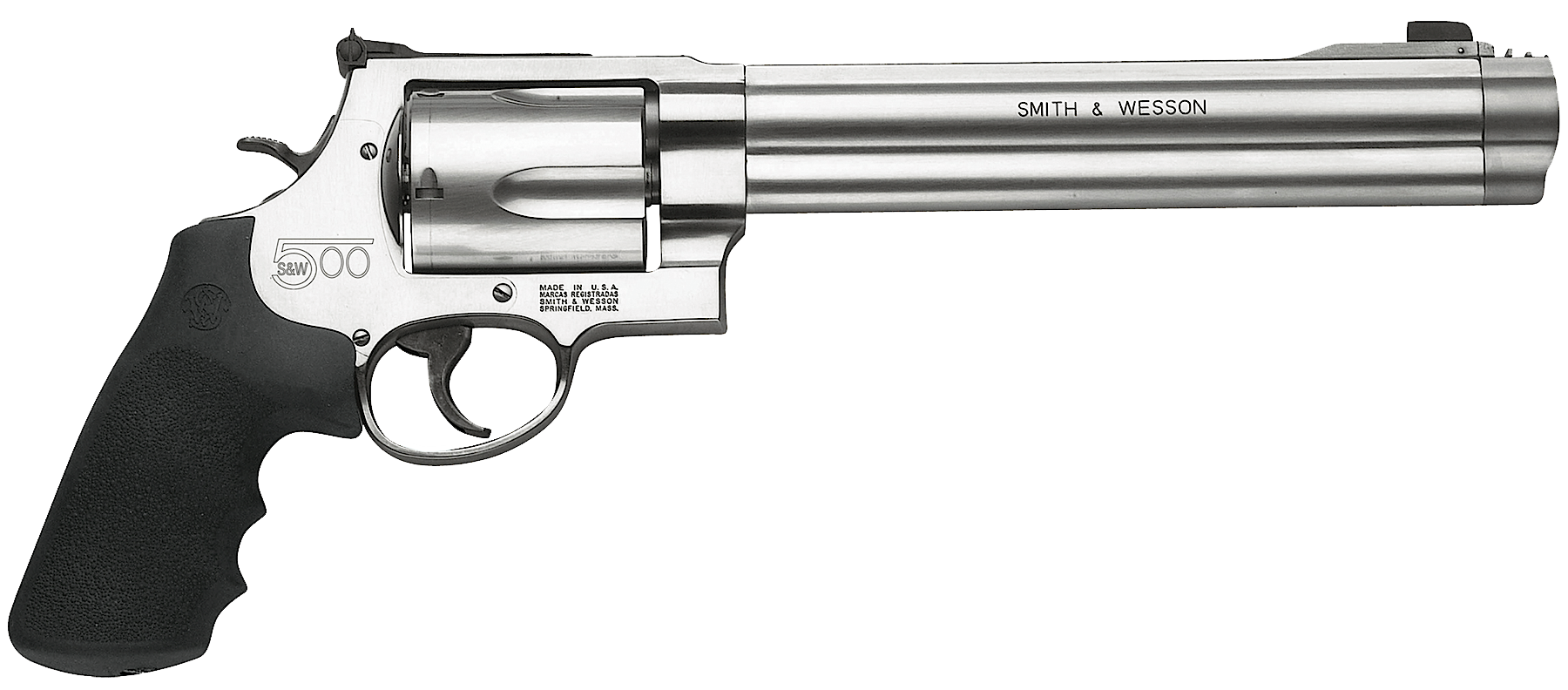Pistols
The Ultimate 2025 Guide to Handguns: Buying, Laws, Costs & Safety
Table of Contents
Handguns are one of the most popular firearm choices for personal defense, concealed carry, and recreational shooting. Thinking of buying your first handgun or upgrading your current sidearm? Whether you are new to firearms or a seasoned shooter, this all-in-one 2025 guide covers everything you need to know about handguns—from costs and types to state-specific regulations, safety tips, and top picks for the year. We’ll walk you through the process, from understanding handgun categories to choosing the right model for concealed carry, home defense, or range use. You’ll also learn how to buy a handgun legally—especially in states like California—and explore the most powerful options available today, along with essential safety tips.
What Are Handguns?
Handguns are compact, easy-to-carry firearms designed to be operated with one hand. They’re ideal for personal defense, concealed carry, home protection, and recreational shooting. In 2025, materials, ergonomics, and modular design advancements have led to more customizable and purpose-built handgun options than ever before. Whether you’re looking for something discreet for everyday carry or a powerful sidearm for backcountry defense, there’s a handgun tailored to meet your specific needs.
Modern handguns often feature enhanced trigger systems, optics-ready slides, modular grip frames, and lightweight polymer or alloy construction, offering better performance without sacrificing reliability. Understanding the different types of handguns available will help you choose the right tool for your intended purpose.
Types of Handguns You’ll Encounter:
- Semi-Automatic Pistols—Popular for self-defense and everyday carry (EDC), these handguns offer quick reloading, higher magazine capacities, and a variety of calibers. They are ideal for both beginners and experienced shooters.
- Revolvers – Known for their mechanical simplicity and reliability. Revolvers are less prone to malfunction, making them a solid choice for first-time handgun owners, hunters, and those in remote environments.
- Small Handguns – Often called subcompacts or micro-compacts, these are designed for maximum concealability. Lightweight and slim, small handguns are perfect for concealed carry permit holders who prioritize discretion.
- Competition & Tactical Pistols—Built for performance and speed, these handguns are often used in shooting sports or by tactical professionals. Features may include optics-ready slides, extended magazines, compensators, custom triggers for faster follow-up shots, and superior control.
How to Buy a Handgun in 2025
Purchasing a firearm in 2025 is more streamlined than ever, thanks to improved systems and excellent consumer education. However, the process remains subject to strict federal and state regulations, especially in states like California.
Here’s a step-by-step overview to help guide you through the process:
- Determine Your Needs – Start by identifying the purpose of your purchase. Are you looking for something suited for self-defense, concealed carry, recreational shooting, or home protection? This will help narrow down your options.
- Understand the Laws – Research both federal and state-specific regulations. Some states have more restrictive policies, such as required safety certifications, magazine capacity limits, and approved model rosters.
- Visit a Licensed Firearms Dealer (FFL) – When you’re ready to purchase, you must do so through a federally licensed dealer. Be prepared to show valid identification and undergo a background check through the National Instant Criminal Background Check System (NICS).
- Fulfill Additional Requirements – Depending on where you live, you may be required to complete a waiting period, obtain a safety certificate, or submit to a fingerprint scan before finalizing the transaction.
- Take Delivery and Register If Needed – Once all requirements are met and any mandatory waiting period has passed, you can take possession of your firearm. In some states, like California, you must register it with local authorities.
Pro Tip: Regulations can change frequently. Always double-check your state’s most up-to-date laws before making a purchase.
Buying a Handgun in California
Purchasing a firearm in California involves navigating one of the most tightly regulated environments in the country. While the process is still manageable, it’s important to understand and prepare for the additional steps required under state law.
Key Points to Know:
- Approved Handgun Roster: Only firearms listed on the California Handgun Roster can be sold by licensed dealers. This roster includes models that have passed state-mandated safety testing and meet microstamping requirements. Many popular models available in other states may not be legal for sale in California.
- Firearm Safety Certificate (FSC): Before purchasing, you must pass a written test covering safe firearm handling, storage, and state laws. Upon passing, you’ll receive an FSC, which is valid for five years and required for all transactions.
- 10-Day Waiting Period: After purchasing your firearm, California enforces a mandatory 10-day waiting period before you can take possession. This applies even if you’ve purchased from the same dealer before or already own firearms.
- Magazine Capacity Limit: California prohibits the sale and transfer of magazines that hold more than 10 rounds. This restriction applies to both newly purchased and inherited firearms unless specifically exempted.
- Ammunition Regulations: In addition to firearm laws, all ammunition purchases in California require a background check and must be conducted through a licensed vendor. Out-of-state ammunition shipments are prohibited unless processed by a California FFL.
- Safe Storage Requirements: California has strict rules regarding secure firearm storage, especially in households with minors. Gun safes or DOJ-approved locking devices are often required at the point of sale.
Disclaimer: Firearm laws in California and across the U.S. are subject to frequent updates. Always consult your state’s Department of Justice or a licensed dealer for the most current legal information before making a purchase.
How Much Does a Handgun Cost?
The price of a handgun can vary widely based on factors like brand reputation, firearm type, included features, and its intended role—whether it’s for everyday carry, home defense, sport shooting, or tactical applications. In 2025, modern pistols are available at nearly every price point, making it easier for buyers to find a reliable option that fits both their budget and needs.
Below is a general breakdown of average price ranges by category:
| Type of Handgun | Average Cost Range (2025) |
|---|---|
| Budget Pistols | $300 – $500 |
| Mid-Tier Semi-Autos | $500 – $800 |
| Premium/Tactical | $800 – $1,500+ |
| Compact Revolvers | $400 – $700 |
| Competition Pistols | $1,000 – $2,000+ |
What Affects the Price?
- Build Quality: Firearms made with premium materials or higher-end finishes (like stainless steel or custom coatings) usually command higher prices.
- Brand Name: Well-established manufacturers like Glock, Sig Sauer, HK, and Smith & Wesson often cost more than budget brands, but they also come with trusted reliability.
- Features: Optics-ready slides, threaded barrels, night sights, and improved trigger systems add to the overall price.
- Purpose: Handguns intended for competition or tactical use often include specialized enhancements and require tighter tolerances—driving up costs.
For first-time buyers, budget-friendly models still offer dependable performance for range practice and home defense. If you’re looking for more advanced capabilities or specific features, expect to pay more—but also gain more in performance and versatility.
How Much Is a Glock Handgun in 2025?
Glock remains one of the most reliable and widely used handgun brands globally—trusted by law enforcement, military personnel, and civilian shooters alike. Known for their simplicity, durability, and ease of use, Glock pistols are often a top choice for those seeking a dependable sidearm with minimal maintenance.
In 2025, the following models remain popular:
- Glock 19 – ~$550
A compact 9mm that’s ideal for concealed carry or general-purpose use. It offers a balanced size with 15+1 capacity and is often considered the “Goldilocks” of Glocks. - Glock 17 (Full-Size) – ~$600
The full-size 9mm version with a 17+1 capacity. It’s a staple in duty use and popular with home defenders and range shooters alike. - Glock 43X (Slimline Series) – ~$480 – $530
Designed for deep concealment while still offering a comfortable grip and 10-round capacity. The 43X is slightly shorter in length than the 48, making it slightly easier to conceal. - Glock 20 – ~$700+
Built for power and versatility, this 10mm handgun is optics-ready and ideal for backcountry defense or those seeking increased terminal performance.
What Impacts Glock Pricing?
- MOS (Modular Optic System) configurations typically cost more than standard versions due to added versatility for mounting red dot sights.
- Aftermarket Upgrades like night sights, performance triggers, and slide milling can significantly increase total cost.
- Limited Editions or Special Runs—such as FDE finishes or factory threaded barrels—are often priced higher due to demand and exclusivity.
- Regional Availability may also affect cost, particularly in states with handgun roster restrictions like California.
Despite the price differences between models, Glock continues to deliver excellent value across its entire lineup—whether you’re looking for a compact carry option or a powerful sidearm for the outdoors.
Top Picks: Most Powerful Handguns You Can Legally Own in 2025
Looking for serious stopping power? Whether you’re preparing for backcountry defense, handgun hunting, or simply want a high-performance sidearm, there are several the most powerful handgun options on the market that push the limits of what handguns can do—while still being legal for civilian ownership. These models are known for their high energy output, heavy calibers, and exceptional terminal performance.
1. Smith & Wesson Model 500 (.500 S&W Magnum)
This revolver is widely considered the most powerful production handgun in the world. Firing the massive .500 S&W Magnum round, the Model 500 delivers extreme muzzle energy—making it a top choice for handgun hunters targeting large game like elk, bear, or even bison. Built on Smith & Wesson’s X-Frame, it features a compensator to help tame recoil and a robust design for long-term durability.
2. Desert Eagle Mark XIX (.50 AE)
The Desert Eagle is an icon in both pop culture and the firearms community—and for good reason. Chambered in .50 Action Express, this gas-operated semi-auto handgun delivers serious punch in a heavy, attention-grabbing frame. While not ideal for concealed carry, it’s popular among collectors, enthusiasts, and those seeking raw power in a semi-automatic platform. Recoil is substantial, but manageable with practice.
3. Ruger Super Redhawk (.454 Casull)
Combining the strength of a revolver with high-powered performance, the Super Redhawk in .454 Casull is a favorite among handgun hunters. Offering a step up from .44 Magnum, it’s capable of stopping large game cleanly and is also a solid choice for defense in bear country. Ruger’s reputation for rugged construction and reliable mechanics makes this revolver a dependable field companion.
4. Glock 20 Gen 5 MOS (10mm Auto)
The Glock 20 brings power and practicality together. Chambered in 10mm Auto, it provides greater velocity and energy than standard 9mm or .45 ACP—making it suitable for self-defense in areas where predators may be a concern. The Gen 5 MOS model adds optics-ready capabilities and improved ergonomics. With a 15+1 capacity, it offers a compelling balance between firepower and controllability.
5. FN Five-seveN Mk3 MRD (5.7x28mm)
The FN Five-seveN is a unique semi-auto pistol that fires the high-velocity 5.7x28mm cartridge. Originally developed for military use, the round offers flat shooting, armor-penetrating potential (with specific ammo types), and very low recoil. The Mk3 MRD model includes an optics-ready slide and improved ergonomics. Its lightweight polymer frame and 20-round magazine make it ideal for high-volume shooters or those seeking speed over raw energy.
Handguns for Various Purposes
Choosing the right firearm comes down to your intended use. Whether you’re looking for a compact sidearm for everyday carry or a heavy-duty revolver for backcountry defense, aligning your choice with your lifestyle and environment is essential. Below is a breakdown of recommended handgun types based on common use cases:
| Purpose | Recommended Type |
|---|---|
| Self-Defense | Compact 9mm (e.g., Glock 19, Sig Sauer P365) |
| Concealed Carry | Micro-compact pistols (.380 ACP, 9mm) |
| Home Defense | Full-size pistols in 9mm or .45 ACP |
| Hunting/Backcountry | Large-caliber revolvers (.357 Mag, .44 Mag, .454 Casull) |
| Target Shooting | Full-size semi-autos with longer barrels (5″+) |
Use-Case Insights:
- Self-Defense:
Compact 9mm handguns offer a balance between size, capacity, and recoil control. They’re easy to carry, quick to deploy, and offer enough firepower to stop a threat effectively without being too bulky. - Concealed Carry:
Micro-compacts handguns are specifically engineered for minimal printing under clothing. Lightweight and slim, models like the Glock 43X or Ruger Max-9 are ideal for discreet daily carry while still offering manageable recoil and sufficient capacity. - Home Defense:
Full-size handguns offer better handling, less felt recoil, and increased magazine capacity. Night sights, weapon lights, and optic-ready features can enhance performance in low-light or high-stress scenarios. - Hunting & Backcountry Defense:
In wilderness environments where larger predators are a concern, revolvers chambered in heavy calibers like .44 Magnum or .454 Casull provide the necessary stopping power and reliability under harsh conditions. - Target Shooting:
For range use or competition, longer-barreled full-size handguns offer greater sight radius, reduced recoil, and improved accuracy. Many target models also include performance triggers and optic-ready features for competitive shooting.
Handgun Safety: Must-Know Tips for 2025
Whether you’re a first-time buyer or a long-time concealed carrier, one rule remains the same: handgun safety is non-negotiable. Responsible ownership isn’t just about knowing how to shoot—it’s about understanding the importance of storage, handling, and awareness at all times. In 2025, with firearm ownership on the rise and more families introducing firearms into their homes, proper safety practices are more critical than ever.
Core Handgun Safety Principles
These golden rules apply to everyone—no matter your experience level or how often you carry or use your handguns.
- Always Treat Every Gun as Loaded
Even if you’re certain your firearm is unloaded, never assume. Check it yourself—visually and physically—every time you handle it. - Keep Your Finger Off the Trigger Until Ready to Shoot
Good trigger discipline prevents accidental discharges. Your finger should rest on the frame, not the trigger guard, until you’re ready to fire. - Never Point Your Firearm at Anything You Don’t Intend to Shoot
Always be aware of muzzle direction. Whether cleaning, loading, or simply showing someone your pistol, the muzzle should never be directed at anything you’re not willing to destroy. - Know Your Target and What’s Beyond It
Be certain of your target and everything behind it. Bullets can travel through walls, people, and unintended targets—especially in defensive scenarios or populated areas. - Use a Gun Safe or Locking Device
Secure storage is key to preventing unauthorized access, especially in homes with children or visitors. A good handgun safe ensures your firearm is accessible when you need it—but protected when you don’t. - Educate Everyone in Your Household
Make firearm safety a shared responsibility. Ensure that family members, especially children, understand not to touch a firearm without supervision and know the basics of what to do if they come across one.
Best Handgun Safes for 2025
When it comes to keeping your firearm secure yet accessible, these handgun safes offer a great balance of modern technology, durability, and quick access:
- Vaultek VT20i Smart Safe
Features Bluetooth-enabled access, biometric fingerprint scanning, and an interior LED light—perfect for nightstand storage. You can also track entry logs via the Vaultek app. - Fort Knox PB1
Built like a tank, this heavy-duty mechanical handgun safe doesn’t rely on batteries or electronics. It uses a Simplex push-button lock and is ideal for those who prefer manual reliability. - Hornady RAPiD Safe Night Guard
Designed for bedside use, this RFID-accessible safe blends seamlessly into your bedroom with a clock-like appearance. It allows fast access using an RFID wristband, key fob, or sticker.
By following these essential safety tips and investing in proper storage, you can ensure responsible ownership and peace of mind. Remember: a secure firearm is a safe firearm—and safety should always come before convenience or complacency.
Frequently Asked Questions About Handguns
If you’re considering purchasing a handgun in 2025, it’s natural to have questions. From legal requirements to safety and choosing the right model, understanding the basics of handgun ownership is essential. Below are answers to some of the most common questions new and experienced gun owners have about handguns.
1. What’s the best handgun for beginners?
For new shooters, the best handguns are typically 9mm semi-automatic pistols. They offer manageable recoil, affordable ammunition, and straightforward operation. Models like the Glock 19, Sig Sauer P365, and Smith & Wesson M&P9 are excellent beginner-friendly handguns known for their reliability and ease of use.
2. Do I need a permit to buy a handgun?
Permit requirements depend on your state. Some states require a handgun permit, background check, or firearm safety certificate. In California, for example, buyers must pass a written test to obtain a Firearm Safety Certificate (FSC) before legally purchasing a handgun from a licensed dealer.
3. How many rounds can a handgun legally hold?
The legal magazine capacity for handguns varies by state. While many handguns come standard with 15- to 17-round magazines, states like California limit handguns to 10-round magazines. Always check your local handgun laws before purchasing or carrying high-capacity magazines.
4. What’s the difference between a revolver and a semi-automatic handgun?
A revolver holds its rounds in a rotating cylinder and is prized for its simplicity and ruggedness. A semi-automatic handgun uses a magazine to feed rounds into the chamber and is typically faster to reload with greater capacity—making it more common for personal defense and concealed carry.
5. Can I carry a handgun for self-defense?
Yes, in many states you can carry a handgun for personal protection, but you may need a concealed carry permit (CCW) depending on local laws. Some states allow constitutional carry, while others require training and background checks. Be sure to verify your state’s handgun carry regulations before carrying.
6. How much does a good handgun cost in 2025?
The price of a quality handgun in 2025 depends on the brand, features, and purpose. Entry-level handguns start around $300–$500, mid-range models cost $500–$800, and high-end tactical or competition handguns can exceed $1,500. Even affordable handguns can offer excellent reliability with proper maintenance.
7. What is the most powerful handgun available to civilians?
The Smith & Wesson Model 500, chambered in .500 S&W Magnum, is widely regarded as the most powerful production handgun available to civilians. This handgun is built for hunting large game and wilderness defense, delivering extreme muzzle energy and stopping power.
8. How should I store my handgun safely at home?
Proper handgun storage is critical for safety. Always keep handguns in a locked safe or secure container, especially in homes with children. In 2025, many handgun safes feature biometric, RFID, or mechanical locks for quick yet secure access. Safe storage prevents accidents and unauthorized use.
Final Thoughts: Choosing the Right Handgun in 2025
From understanding how much a handgun costs to navigating California’s legal requirements and picking the most potent or concealable option, there’s much to consider when choosing your sidearm. Factors like intended use, comfort, legal compliance, and budget all play a role in finding the right fit for you.
Whether you’re looking for a compact pistol for everyday carry, a full-size model for home defense, or a heavy-caliber revolver for backcountry protection, the options in 2025 are more advanced and versatile than ever. Taking time to evaluate your needs, familiarize yourself with safety best practices, and stay informed about evolving state and federal regulations will ensure you’re making a smart and lawful decision.
With the proper research, training, and commitment to safety, owning a handgun can be a responsible and empowering choice—whether for defense, recreation, or preparedness. Responsible ownership starts with informed choices.
Explore our full selection of handguns at Dirty Bird Industries to find the perfect match for your needs.
